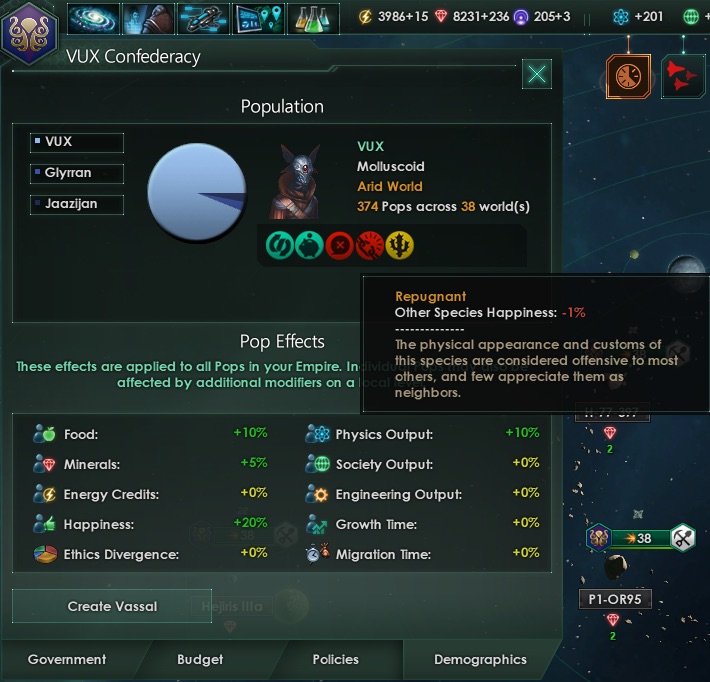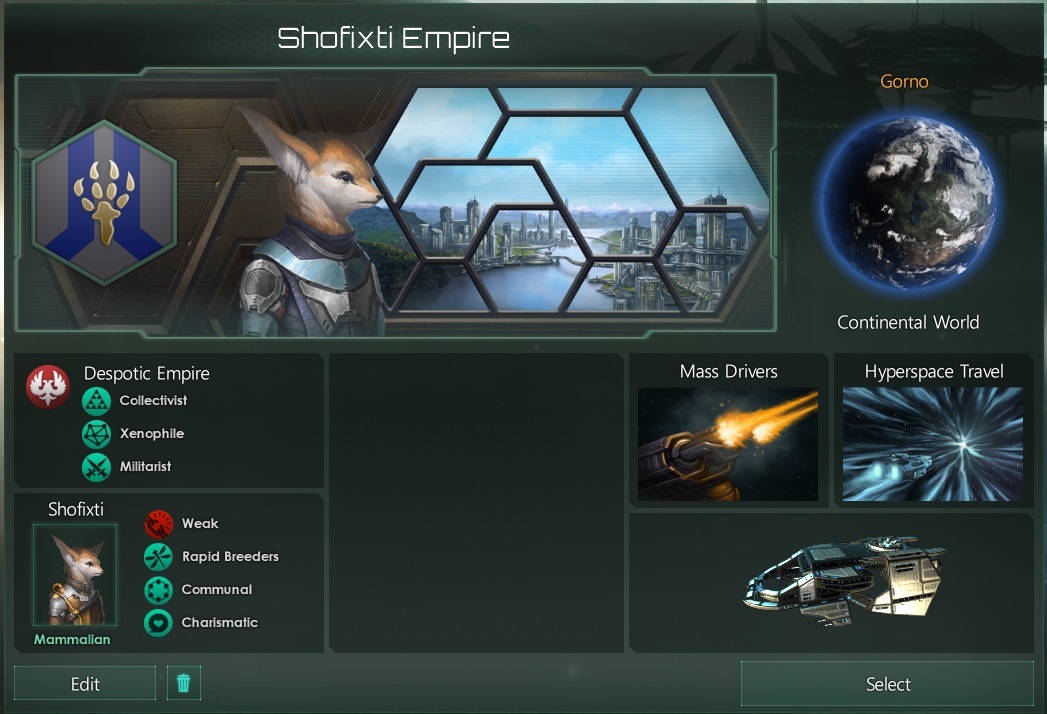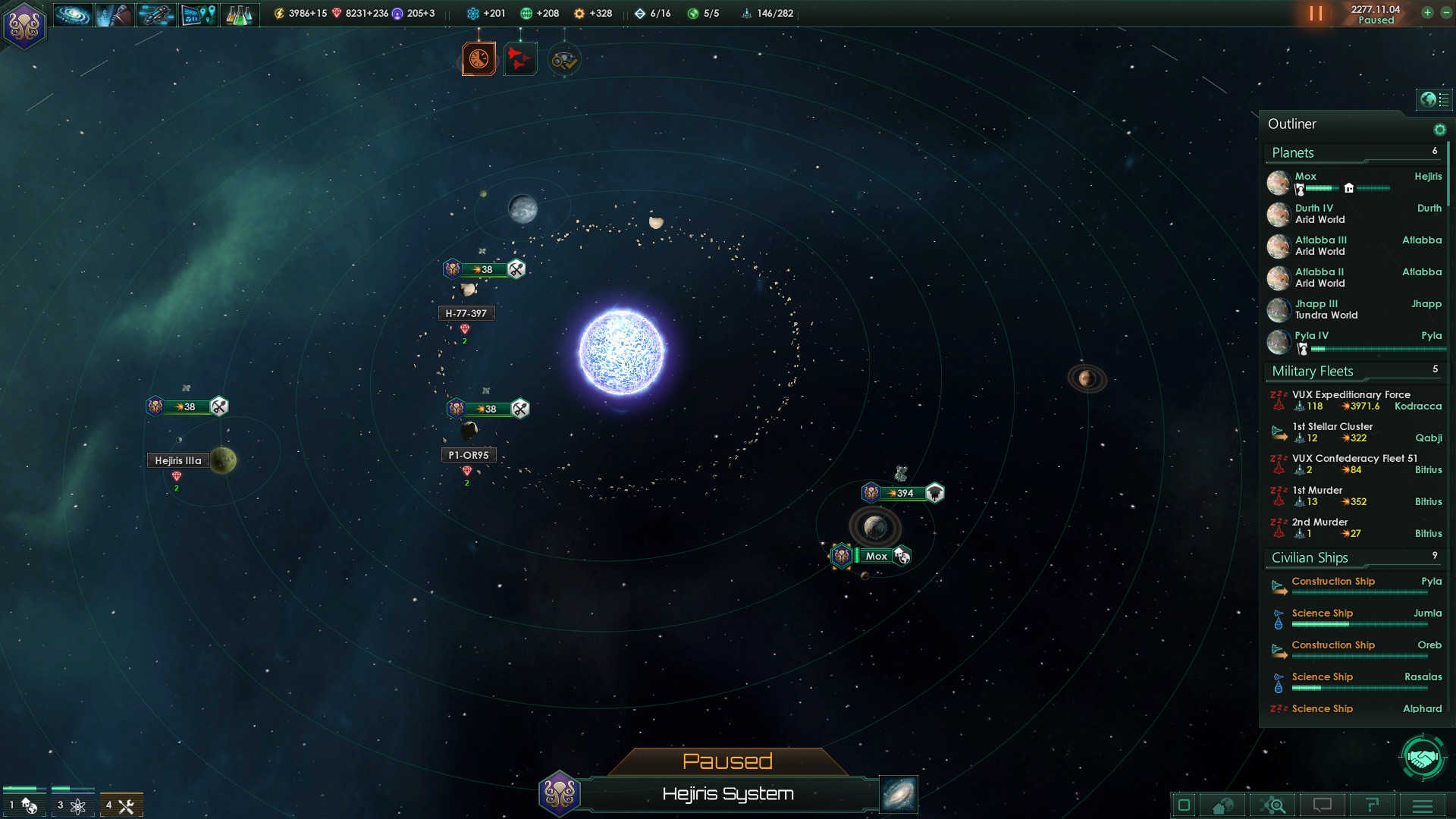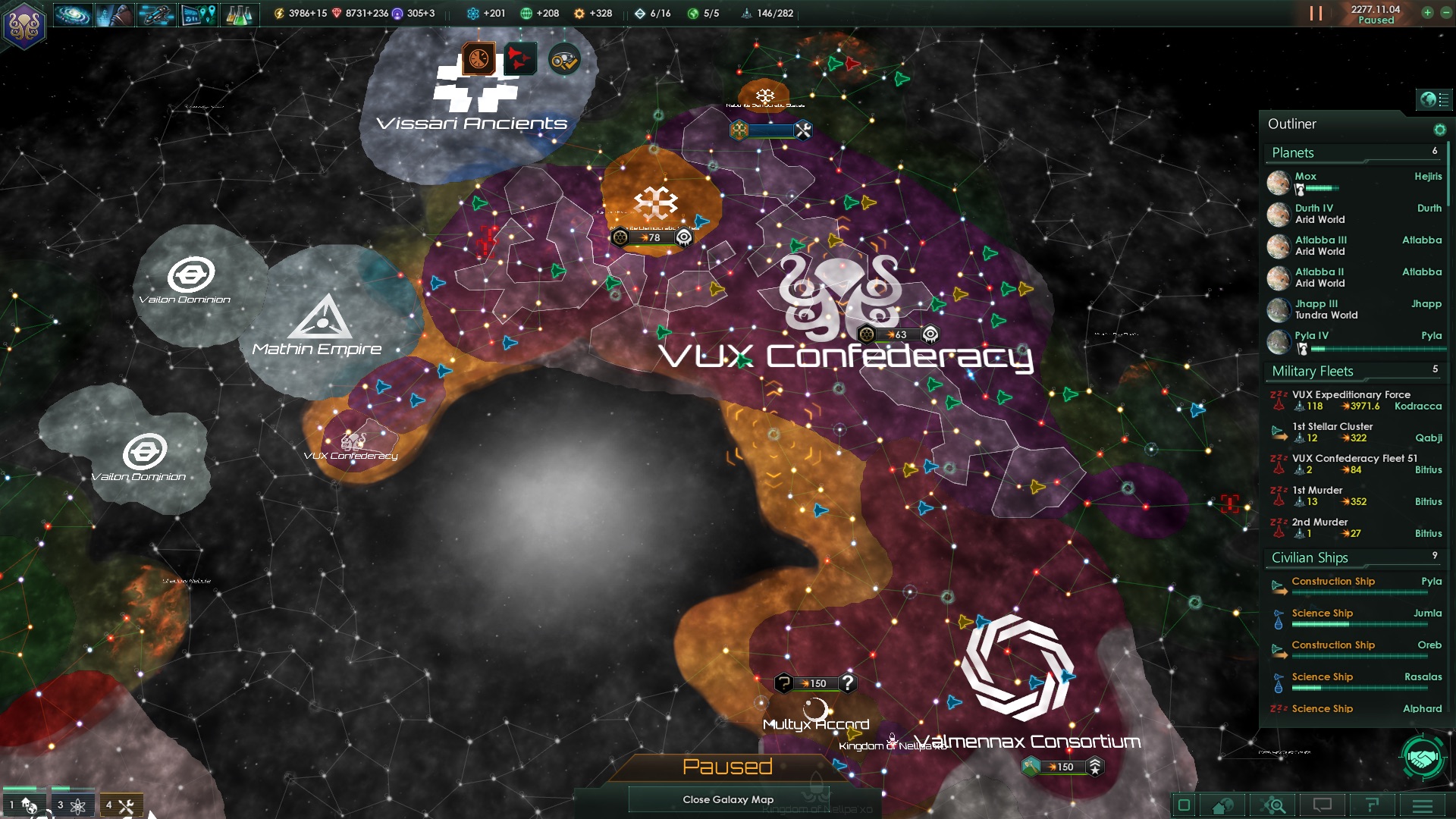Stellaris
Jun 5, 2016 · peterb · 8 minute readGames
The things we want are not always the same as the things that we need.
What we want, in this case, is Stellaris, a strategic space conquest game that is epic in scope. It is, without question, the galaxy-spanning, world-building, spaceship-fighting, technology tree-climbing, planet-developing, Space Octopus-negotiating, ore-mining, hyperspace-traveling game you have been waiting for. If you are a person who likes this sort of game - and by this point in the review, you already know if you are! - you should get it.
I’ve been avoiding calling Stellaris what it is because the name for this type of game is “4X”, which is, if we’re honest, a punishingly stupid name. I don’t want to go deep into the history of 4X games here, but fortunately I’ve already done so, in detail, back in 2007, with a complete series of articles talking about their history and some examples. So if you’re interested in that, rather than Stellaris proper, go read that now.

Stellaris is what happens when the makers of the grand strategy series Europa Universalis and Crusader Kings turn their analytical eyes towards the sky. In retrospect, it’s surprising they hadn’t done this earlier. The size of the arena of play is commensurate to their ambitions.
I will be honest, I was not optimistic about this: my love/hate relationship with the EU games is well-documented on Tea Leaves. To friends, I’ve often described my conundrum as “I like reading about other people’s playthroughs of EU more than I like actually playing it.” Stellaris, as expected, borrows much of the underlying user interface and game concepts from the earlier games - the way the game clock ticks, the real-time-but-pause-frequently cadence is the same, the way musket infantry are mustered super-futuristic spaceships are requisitioned and march slowly from province to province fly through hyperspace lanes are the same.
But you know what? It works! I expected the UI to hang on Stellaris like a too-big jacket, but instead it looks finely-tailored. Either Paradox did a bunch of tuning that operates on an almost subconscious level, or Stellaris is the game this UI has been waiting for. The UI works better in this game than it did in EU IV.
You start your game by choosing one of the pre-existing space-faring races, or by diving into the species creator. (Tangent: some day I will write an article about the troubling aspects of species or race in exploration games and how it sanitizes and encodes European colonial prejudices in the deepest levels of gameplay. But today is not that day, and to be fair the species-centric gameplay was embedded in 4X games long before Paradox came to the genre.)
I, of course, was compelled to create my own – well, honestly, re-create somebody else’s – species.

I might have gone a little overboard with it.

You begin the game proper, as you might expect, with one star system, an exploration ship (search for resources and drive story events), a construction ship (build stations to mine resources), and a small military fleet (shoot to kill things). An optional set of tutorials gradually introduces the (many, many) game systems to you via a series of missions. The early game is spent exploring your star system and your immediate neighbors and trying to jump-start production and technology development.
The number of systems in the game is staggering. In no particular order, we’ve got: exploring to find resources and “special events”, mining networks to support construction, energy networks to support maintenance of fleets and colonies, agriculture to support population growth and citizen happiness, citizen happiness as a driver for rebellion and/or productivity, three different research trees with associated resources, primitive pre-spacefaring civilizations that can be “uplifted” (there’s that tangent again…), diplomacy with other empires including alliances and vassals, a multi-tiered rock-paper-scissors way of building out your space armadas, combat of said armadas, ground combat including orbital bombardament, three completely different technologies with different attributes for moving from star system to star system, the door that opens on my story, that would surprise me, if it opens, it will be I, it will be the silence, where I am, I don’t know, I’ll never know, in the silence you don’t know, you must go on, I can’t go on, I’ll go on.1

So if you like games with lots of complicated systems interacting in different ways, Stellaris is not just the game you want, it’s probably also the game you need. But I’m not actually a fan of this level of complexity - I think that richness is good and complexity is bad, and so for me, the number of systems in Stellaris is something I deal with, rather than revel in, to get to what I think is the actually good part.
The actually good part of the game is the event system. The actually good part of the game is that it lets us tell ourselves an interesting story.
As in Crusader Kings II, periodically strange events happen (sometimes randomly, more often as a result of one of your science ships investigating a stellar object.) You’ll have to make decision as a result of these events. Sometimes that will resolve the matter, but other times it will turn out that you’ve pulled the string that will begin to lead you to a strange and wonderful place. In moments like that, Stellaris truly shines.
And let me be clear that I’m not criticizing Paradox for making the game systems as complex as they are. If anything, I’m critcizing us, the players, who know what we want, but not what we need. The best 4X games, by which I mean precisely “Spaceward Ho!” and the original “Master of Orion,” and probably no others, were games that felt huge but were small. To take a single example, in those games you had a multiplicity of star systems, which had (at most!) a single planet. Each system presented an interesting set of decisions - do I colonize this planet, do I expect it to make a profit or just strip-mine it, should I abandon it? - but did not interrupt the larger strategic game with layers upon layers of micromanagement.
This is the alchemy of game design, when you can make a game that is simple enough for anyone to pick up, where the rules can be explained in 5 minutes, yet which can hold people’s attention for hours. But the trajectory of 4X games has been in the opposite direction: if big is good, reason gamers, bigger must be even better! And so we have Master of Orion 2, which grafted on Master of Magic' terrible city-building minigame, and Galactic Civilization with its plethora of tech tree decisions, most of which are pointless, to Stellaris. Which accepts all of those strategic layers, the near sight of the mere size of them, the moyles and moyles of them2 as a given.

To its credit, Stellaris tries to make the most of this assumption, and tries to make its systems all meaningful. But the result of this is that you scale your empire, and the game does not scale with it. Paradox themselves recognized this, and introduced a system whose job it was was to manage all the other systems, wherein you designate a number of star systems as a “sector” which is then auto-governed. But it doesn’t work as well as you’d like, so at the end of the day you end up micromanaging things that aren’t interesting at scale, and spend time daydreaming about the creation of new game systems to manage the existing game systems (“It would be great if I could set a rally point so that the 40 corvettes I just built on different planets could all show up at the same place without me individually routing them”, “It would be great if I could set a strategic direction for technology research instead of discovering that my scientists have been doing nothing but playing foosball for 6 months because I missed a notification.” “It would be great if I could have my construction ships auto-build stations that improve certain resources instead of me individually looking at the icons under each star system on my 100-system map while holding down the ‘alt’ key.”
I know, I know: I’m a complainer. And if it sounds like I’m saying the game isn’t good, I’m not making myself clear: it’s great. I’ve spent 30+ hours in-universe in the game and always want to know what happens next. And given Paradox’s stellar3 track record with Crusader Kings II, I have no doubt that there will be quality of life additions on a regular basis that address some of these issues. I think what I am saying is: this is a great game, but it is a gamer’s game. The very elements that make it so epic in scope are the same elements that will prevent it from being, in years to come, considered a classic. They are the same elements that explain why even non-gamers have heard of Civilization, but they have not heard of Europa Universalis.
Stellaris ($39.99 on Steam) is the modern 4X game that we want. It’s the game that I want. But I think it is probably not the modern 4X game we need. That game is still out there, yearning to be written. So you should play Stellaris; it’s a great game, and will continue to become a greater one.
But keep watching the stars.
Disclosure statement: Paradox Games graciously provided Tea Leaves with a review copy of Stellaris.
1 Apologies to Samuel Beckett.
2 Apologies to James Joyce.
3 No pun intended.